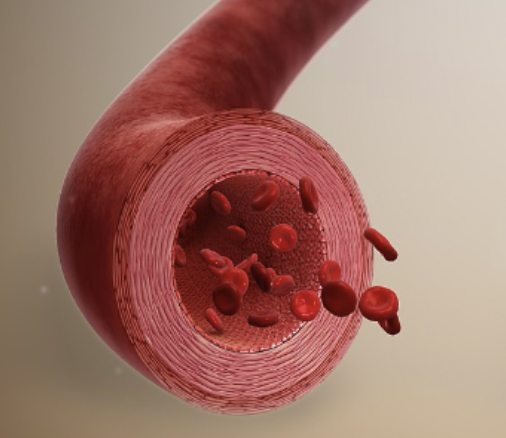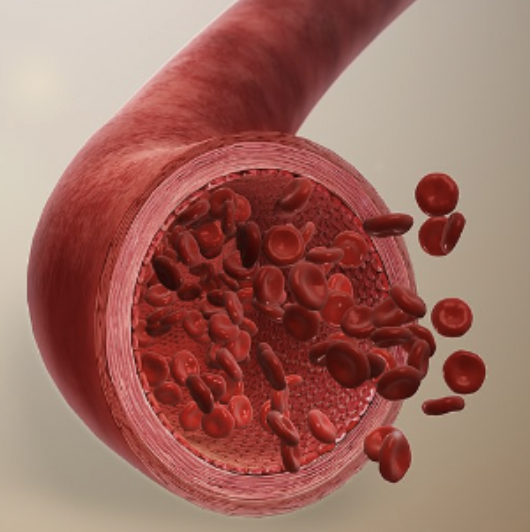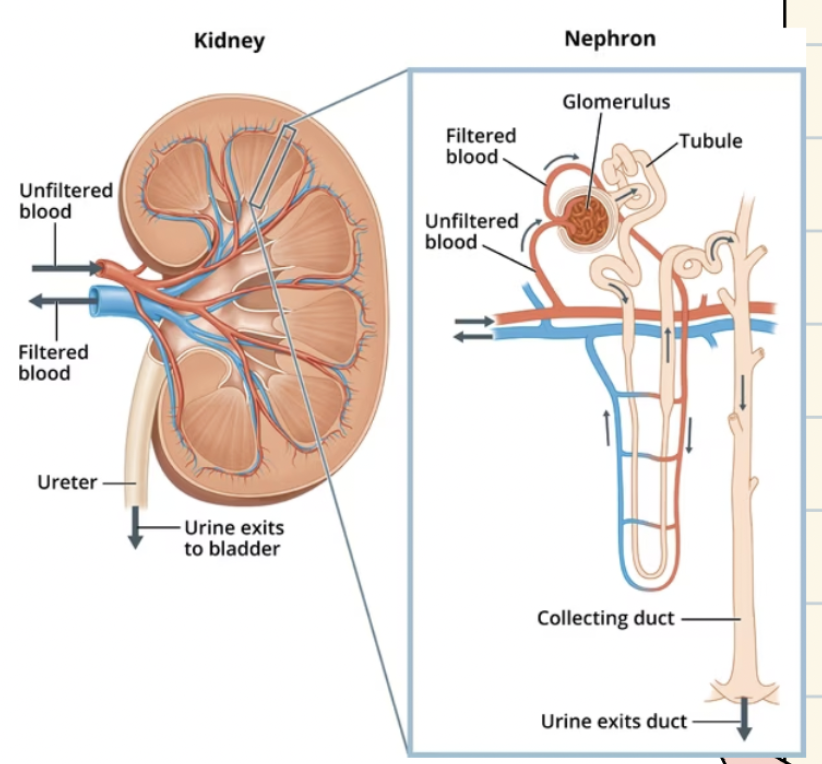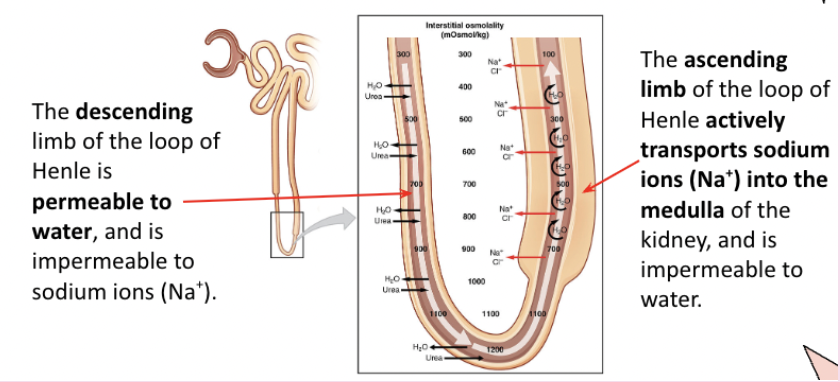Homestasis Test
1/47
There's no tags or description
Looks like no tags are added yet.
Name | Mastery | Learn | Test | Matching | Spaced |
|---|
No study sessions yet.
48 Terms
Homeostasis
Homeostasis is maintaining a stable internal environment of the body within preset limits, despite fluctuations in the external environment.
Homeostasis regulates a range of variables in humans, including:
Body Temperature: The normal range for adult body temperature is 36.0°C to 37.5°C
Blood pH: The range of blood pH in humans is 7.35 to 7.45.
Blood Glucose Levels: The range of fasting blood glucose levels is 3.9mmol/L to 5.6 mmol/L. Blood glucose levels increase after a meal, but they return to the normal range within a few hours.
Blood Osmotic Concentration: The normal range for blood osmolarity is approximately 275 mOsm/kg to 295 mOsm/kg of water.
Blood osmotic concentration is a measure of the concentration of solutes in the blood.
Negative Feedback
Negative feedback is a response which reverses a detected change, to return the body to homeostatic equilibrium.
Negative feedback returns homeostatic variables to a set point.
If a homeostatic variable increases, negative feedback acts to decrease the variable and return it to the set point.
If a homeostatic variable decreases, negative feedback acts to increase the variable and return it to the set point.
Example: osmoregulation through ADH release to reduce stimulus and restore balance.
Positive Feedback
Positive feedback is a response which amplifies a detected change.
Positive feedback amplifies a detected change. If a variable was increasing or decreasing, positive feedback would further increase or decrease the variable. The variable would not return to a set point.
Negative feedback reverses a change in a variable, so an increase or decrease would be reversed - returning the variable to the normal set point.
Example: oxytocin release during childbirth, causing uterine muscles to contract, pushing the baby.
Hormones
The hormones insulin and glucagon regulate blood glucose levels.
The range of normal fasting blood glucose levels is 3.9mmol/L to 5.6 mmol/L.
Hormones are chemical messengers released by endocrine glands.
Hormones are transported to target cells by the bloodstream.
Alpha cells of Islets of Langerhans
Blood glucose levels decrease during exercise, and this is detected by the pancreas. The following events occur, to increase blood glucose levels back to the normal range:
Alpha (𝝰) cells in the Islets of Langerhans in the pancreas secrete glucagon into the bloodstream.
Glucagon travels through the bloodstream to the liver cells.
Glucagon binds to glucagon receptors on the liver cells.
The glucagon triggers the liver cells to convert glycogen to glucose, which is released into the bloodstream.
Regulation of blood glucose levels is an example of negative feedback loops in homeostasis.
Beta cells of Islets of Langerhans
Blood glucose levels increase after a meal, and this is detected by the pancreas. The following events occur, to lower blood glucose levels back to the normal range:
Beta (β) cells in the Islets of Langerhans in the pancreas secrete insulin into the bloodstream.
Insulin travels through the bloodstream to target cells, including liver and muscle cells.
Insulin binds to insulin receptors on the surface of target cells, which causes cells to remove glucose from the bloodstream.
Liver cells convert glucose to glycogen for storage.
Muscle cells use increased quantities of glucose for aerobic respiration.
Insulin
Insulin is a hormone produced by the pancreas that regulates blood sugar levels by facilitating the uptake of glucose into cells for energy or storage as glycogen. It helps lower blood sugar levels and maintain balance in the body.
Insulin does the opposite of glucagon. It is used when there is too much blood sugar (hyperglycemia). Insulin lowers blood glucose levels by helping cells absorb glucose and storing excess glucose as glycogen in the liver. Together, insulin and glucagon maintain blood sugar balance.
Insulin regulation = negative feedback mechanism
Glucagon
Glucagon is a hormone produced by the pancreas that raises blood sugar levels by stimulating the liver to break down glycogen into glucose and release it into the bloodstream. It works opposite to insulin to maintain blood glucose balance.
Glucagon is used when there is too little blood sugar (hypoglycemia). It raises blood glucose levels by signaling the liver to release stored glucose into the bloodstream, helping restore balance.
Also negative feedback mechanism
Glycogen
Glycogen is a stored form of glucose, primarily found in the liver and muscles. It serves as an energy reserve, releasing glucose into the bloodstream when needed, such as during fasting, exercise, or low blood sugar.
Diabetes
Diabetes is a chronic condition where the body cannot properly regulate blood sugar (glucose) levels. This happens due to insufficient insulin production or the body not using insulin effectively.
Type 1 Diabetes
The body's immune system mistakenly attacks the beta cells in the pancreas, which are responsible for producing insulin. Since these cells are damaged or destroyed, the body is no longer able to produce insulin, a hormone essential for regulating blood sugar levels. Without insulin, glucose cannot enter the cells for energy and builds up in the bloodstream instead.
Type 2 Diabetes
Type 2 diabetes occurs when the beta cells in the pancreas produce insulin, but the liver and muscle cells don’t respond to it properly. This is called insulin resistance, where the target cells are resistant to insulin’s effects, leading to high blood sugar levels.
Thermoregulation
Thermoregulation is the process by which an organism maintains its body temperature within a narrow range.
Thermoregulation involves negative feedback loops to maintain body temperature.
Peripheral Thermoreceptors
Peripheral thermoreceptors monitor body temperature. When peripheral thermoreceptors sense a change in body temperature, they send nerve signals to the thermoregulatory centre of the hypothalamus in the brain.
The hypothalamus monitors body temperature, and initiates a range of negative feedback responses to warm up or cool down the body as required.
The hypothalamus sends nerve signals to the skeletal muscles when body temperature drops, which results in shivering. The muscles are examples of effectors (they are stimulated by motor neurons).
The pituitary gland secretes thyroid stimulating hormone which regulates the secretion of thyroxine from the thyroid gland.
The thyroid gland secretes the hormone thyroxine which is involved in the control of metabolic rate in cells of the body. An increase in thyroxine levels leads to an increase in the rate of metabolism. Metabolism generates heat to warm up the body.
Adipose tissue (body fat) is found under the skin, and acts as an insulator, reducing heat loss.
Thermoregulatory Centre
The thermoregulatory centre is a part of the brain, located in the hypothalamus, that controls body temperature. It detects changes in temperature through signals from the skin and the blood (like shivering) and triggers responses to keep the body at a stable temperature.
Thyroid Stimulating Hormone
The pituitary gland secretes thyroid stimulating hormone (TSH), which controls the release of thyroxine (T4) from the thyroid gland. Thyroxine regulates metabolism, energy production, and growth in the body. TSH ensures the thyroid gland produces the right amount of thyroxine to maintain balance.
Thyroxin
Thyroxine (T4) is a hormone produced by the thyroid gland. It plays a key role in regulating the body's metabolism, influencing how the body uses energy, controls temperature, and maintains growth and development. Thyroxine helps control the rate at which cells perform their functions by increasing the rate of metabolism in tissues.
Adipose Tissue
Adipose tissue is a type of body tissue that stores fat. It provides energy, insulates the body, and protects organs.
Endotherm
Endotherms such as birds and mammals use physiological means of regulating body temperature. Endotherms are animals that generate internal heat to maintain body temperature.

Vasoconstriction
Vasoconstriction is the narrowing of blood vessels, resulting in less blood flowing through the blood vessels.
When the body is cold, blood vessels near the skin vasoconstrict, reducing heat loss from the blood through the skin.

Vasodilation
Vasodilation is the widening of blood vessels, resulting in more blood flowing through the blood vessels.
When the body is hot, blood vessels near the skin vasodilate, increasing heat loss through the skin.
Shivering
The body starts to shiver when it is cold. Shivering is caused by the rapid involuntary contraction and relaxation of skeletal muscles.
Muscle contractions require energy in the form of ATP. The generation of ATP by respiration releases heat energy to warm up the body.
Sweating
The body sweats when it is hot. Sweating is the release of water from the sweat glands. Water evaporates by absorbing heat energy from the skin, helping to cool the body down.
Uncoupled Respiration
Uncoupled respiration is a process where aerobic respiration produces heat instead of ATP (the usual energy form). This occurs in brown adipose tissue (a type of fat) when the body is cold. Instead of using energy to produce ATP, the brown fat burns energy to generate heat, helping warm the body up.
In aerobic respiration, cells usually produce ATP (energy) by using oxygen to break down glucose. However, in uncoupled respiration, this process is altered so that instead of making ATP, the energy is released as heat. This happens when certain proteins in the mitochondria (like those in brown adipose tissue) "uncouple" the normal process, causing energy to be dissipated as heat to help warm the body, especially in cold conditions.
Brown Adipose Tissue
Brown adipose tissue (BAT) is a type of fat that generates heat by burning energy, especially in response to cold. It contains more mitochondria than white fat, which allows it to produce heat through uncoupled respiration.
Kidney
The kidney is an organ that filters waste from the blood, regulates fluid balance, and maintains electrolyte levels. It also helps control blood pressure and produces urine to remove excess substances from the body.
Excretion
Excretion is the removal of metabolic waste from the body. The kidneys are involved in the excretion of the metabolic waste urea.
Osmoregulation
Osmoregulation is the maintenance of an internal balance between water and dissolved materials by an animal, regardless of environmental conditions.
The kidneys help maintain osmotic balance between the concentrations of blood, tissue fluids and the cytoplasm of cells.
The unit for osmotic concentration is osmoles per litre (osmol L−1).
Osmotic Concentration
Osmotic concentration refers to the concentration of solutes (such as salts and other molecules) in a solution, specifically in relation to the movement of water across a membrane. It determines the direction of water flow during osmosis, with water moving from areas of lower solute concentration to areas of higher solute concentration.

Nephron
Nephrons are the functional units of the kidney, which filter blood and produce urine. There are millions of nephrons in each kidney.
The structure of nephrons includes:
Glomerulus
Bowman’s capsule
Proximal convoluted tubule
Loop of Henle
Distal convoluted tubule
Collecting ducts
Glomerulus
Ultrafiltration occurs in the glomerulus, producing a filtrate which enters the Bowman’s capsule of the nephron.
The glomerulus is a cluster of capillaries found in the Bowman’s capsule of a nephron.
Blood enters the glomerular capillaries at high pressure, as the capillaries are much narrower than the arteriole that brings blood to the nephron.
The glomerular capillaries are fenestrated (have many large pores within the walls), allowing 20% of the blood plasma to leak out.
The glomerulus prevents large molecules such as blood cells and large proteins from entering the nephron.
Many useful substances from the blood plasma are in the glomerular filtrate. These useful substances are reabsorbed into the bloodstream as the filtrate passes through the proximal convoluted tubule.
Bowman’s Capsule
The glomerulus produces glomerular filtrate, which enters the nephron through the Bowman’s capsule. It is the first part of the nephron, where blood is filtered. The Bowman's capsule collects the filtrate (water, salts, glucose, urea) from the blood, which will later be processed into urine.
Proximal Convoluted Tubule
The proximal convoluted tubules selectively reabsorb nutrients and most of the water in the filtrate.
All of the glucose and amino acids in the filtrate are actively transported out of the proximal convoluted tubule into the capillaries surrounding the nephron.
80% of the minerals are actively transported out of the tubule into the capillaries.
A high concentration of solutes outside the tubule causes 80% of the water in the filtrate to leave the proximal convoluted tubule by osmosis.

Loop of Henle
The loop of Henle reduces the volume of the filtrate by transporting water and sodium ions (Na+) into the medulla of the kidney.
The proximal convoluted tubule reabsorbs 80% of the water, but that leaves a lot of water that still needs to be reabsorbed.
The ascending and descending limbs of the loop of Henle have different permeabilities to water and sodium ions (Na+).
Distal Convoluted Tubule
The fluid that leaves the loop of Henle and enters the distal convoluted tubule is dilute urine.
The distal convoluted tubule is involved in balancing:
the pH of the blood.
the mineral concentration of the blood.
Collecting Duct
Urine enters the collecting duct after leaving the distal convoluted tubule. All of the useful substances and most of the water have been reabsorbed. The remaining filtrate is now urine. The urine has a high concentration of metabolic wastes such as urea.
Ultrafiltration
Ultrafiltration is the process in the kidneys where blood is filtered under high pressure in the glomerulus to remove waste, water, and small molecules, forming a filtrate in the Bowman's capsule.
Glomerular Filtrate
Glomerular filtrate is the fluid that is filtered from the blood in the glomerulus into the Bowman's capsule. It contains water, glucose, salts, urea, and other small molecules, but no large proteins or blood cells.
Selective Absorption
Selective absorption is the process in the kidneys where useful substances like glucose, amino acids, and certain salts are reabsorbed from the filtrate back into the blood, while waste products remain in the filtrate to form urine.
Selective absorption mainly happens in the proximal convoluted tubule (PCT).
In the PCT, the majority of useful substances like glucose, amino acids, salts, and water are reabsorbed back into the bloodstream.
Active Transport
Active transport is the movement of molecules or ions across a membrane against their concentration gradient, using energy from ATP and specific transport proteins.
Osmoreceptors
Osmoreceptors in the hypothalamus monitor the osmotic concentration of the blood.
The hypothalamus regulates the concentration of the urine by stimulating the pituitary gland to release antidiuretic hormone (ADH) when the osmotic concentration of the blood is too high.
Antidiuretic Hormone (ADH)
Antidiuretic Hormone (ADH) is a hormone released by the pituitary gland that helps regulate water balance in the body. It makes the collecting ducts of the kidneys more permeable to water, allowing more water to be reabsorbed into the bloodstream. This reduces urine volume and prevents dehydration.
Sympathetic Nervous System
The sympathetic nervous system is a part of the autonomic nervous system that prepares the body for "fight or flight" responses during stress or danger. It increases heart rate, widens airways, dilates pupils, and redirects blood flow to muscles, while slowing down non-essential functions like digestion.
Parasympathetic Nervous System
The parasympathetic nervous system is a part of the autonomic nervous system that promotes "rest and digest" functions. It helps the body relax by slowing the heart rate, constricting the airways, stimulating digestion, and conserving energy after stress. It works in opposition to the sympathetic nervous system, which prepares the body for action.
Adaptations of PCT
The proximal convoluted tubules are adapted for their role of reabsorbing nutrients and water. Adaptations include:
Folded, to increase surface area.
Microvilli on the cells, to increase surface area.
One cell thick, allowing rapid transport.
Protein pumps are present in the cells’ plasma membranes, for active transport.
Many mitochondria produce ATP by aerobic respiration, for active transport.
The proximal convoluted tubules are surrounded by capillaries to transport the nutrients and water away from the kidney.
Adaptations of Glomerulus
Adaptations of the glomerulus include:
Fenestrated capillaries
Basement membrane - a glycoprotein which filters the blood plasma
Podocytes - surround the capillaries within the Bowman’s capsule.
Ascending Limb of the Loop of Henle
The ascending limb (↑) of the loop of Henle is impermeable to water, and actively transports sodium ions (Na+) into the medulla of the kidney.
This creates a high sodium ion (Na+) concentration in the medulla as many loops of Henle are actively transporting Na+ into the medulla, ensuring that the medulla is hypertonic compared to the filtrate.
Descending Limb of the Loop of Henle
The descending limb (↓) of the loop of Henle has many aquaporins and is permeable to water (but not Na+).
Water leaves the descending limb by osmosis into the high Na+ concentration of the medulla.